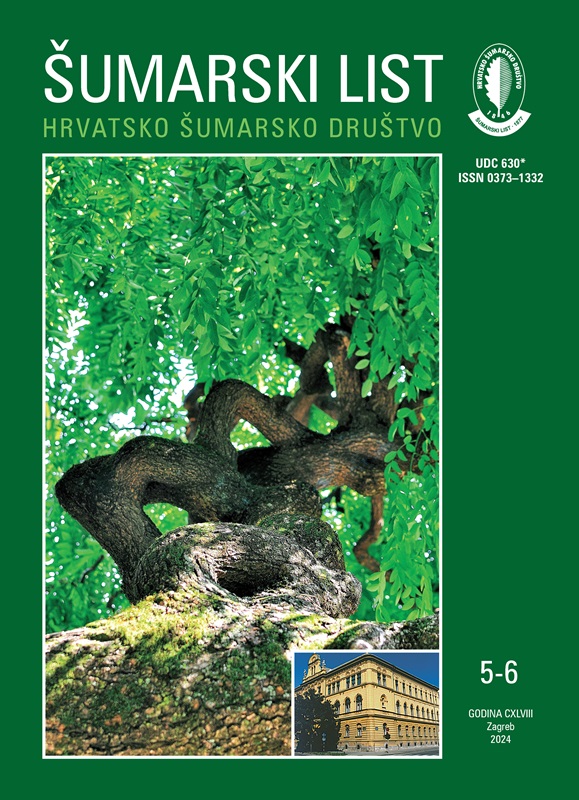
broj: 5-6/2024
pdf (9,7 MB) |
|
||||||||||||||
| RIJEČ UREDNIŠTVA | ||
| Uredništvo HŠD-a | ||
| The scientific and professional character of Forestry Journal pdf HR EN | 217 | |
| IZVORNI ZNANSTVENI ČLANCI | ||
| Igor Poljak, Zlatko Šatović, Antonio Vidaković, Katarina Tumpa, Marilena Idžojtić | UDKps://doi.org/10.31298/sl.148.5-6.1 | |
| Population variability of rosemary willow (Salix eleagnos Scop.) based on leaf morphometry: evidence of small and large-leaf morphotypes pdf HR EN | 219 | |
| Ivan Perković, David Počekal, Vibor Roje, Darko Bakšić, Nikola Pernar | UDKps://doi.org/10.31298/sl.148.5-6.2 | |
| Influence of the parent material on calcocambisol in the area of the Plitvice lakes national park pdf HR EN | 237 | |
| Mirzeta Memišević Hodžić, Dalibor Ballian | UDKps://doi.org/10.31298/sl.148.5-6.3 | |
| Phenological traits of leafing and leaf retention of black poplar (Populus nigra L.) in the clonal archive in Žepče, Bosnia and Herzegovina pdf HR EN | 249 | |
| Ahmet Acarer | UDKps://doi.org/10.31298/sl.148.5-6.4 | |
| Brown bear (Ursus Arctos L.) distribution model in Europe: Current situation and the potential role of climate change pdf HR EN | 261 | |
| Mevlüt Zenbilci, Serkan Özdemir, Alican Çivg˘a, Yasin Ünal, Idris Og˘urlu | UDKps://doi.org/10.31298/sl.148.5-6.5 | |
| Habitat suitability modeling of wild goat (Capra aegagrus Erxleben, 1777) in different periods pdf HR EN | 273 | |
| Gizem Misirliog˘lu, Selçuk Gümüş | UDKps://doi.org/10.31298/sl.148.5-6.6 | |
| Time-dependent change of natural vegetation on forest road fill slopes and its effects on erosion decrease pdf HR EN | 285 | |
| Summary During the construction of forest roads, slopes become more susceptible to erosion as they remain bare due to soil excavation and felling of trees along the road route. In Türkiye, studies are carried out to prevent erosion and maintain slope stability, and it is known that these studies are quite costly. In this study, analyses were made on three forest roads built less than a year ago, 5 years ago and 10 years ago from the forest road network located at the same aspect and level, and the aim was to determine whether these costs were needed. Soil samples were taken from the fill slopes of these roads and the degree of covering of the plants was determined by using the grid method on the images taken with the drone. Analyses of organic matter, texture, stony ratio, and pH-EC determination were made on these soil samples. The vegetation cover of the fill slope surfaces was determined as 93% for the 10-year-old road, 80% for the 5-year-old road and 0% for the newly built road. According to the ABAG method (which is a simulation of the USLE model converted to the metric system and adapted to European conditions), the annual soil loss amount for the 10-year-old forest road was 1.59 tons/ha/years, for the 5-year-old forest road it was 1.75 tons/ha/years and, finally, for the newly built forest road, this value was 15.52 tons/ha/years. Considering that most of the soil loss occurs in the first years, the amount of soil loss determined on the 5-year-old forest road is at an acceptable level according to the erosion values that occur in natural areas. For this reason, considering that the fill slopes are naturally covered with vegetation, it has been determined that there is no need for costly stabilization process in the fill slopes in this study area Keywords: forest roads, slope, erosion, ABAG, vegetation | ||


